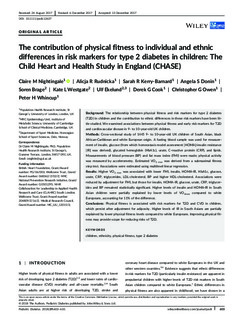The contribution of physical fitness to individual and ethnic differences in risk markers for type 2 diabetes in children: The Child Heart and Health Study in England (CHASE)
| dc.contributor.author | Nightingale, Claire M. | |
| dc.contributor.author | Rudnicka, Alicja R | |
| dc.contributor.author | Kerry-Barnard, Sarah R. | |
| dc.contributor.author | Donin, Angela S. | |
| dc.contributor.author | Brage, Søren | |
| dc.contributor.author | Westgate, Kate L. | |
| dc.contributor.author | Ekelund, Ulf | |
| dc.contributor.author | Cook, Derek G. | |
| dc.contributor.author | Owen, Christopher G. | |
| dc.contributor.author | Whincup, Peter H. | |
| dc.date.accessioned | 2018-09-05T08:33:22Z | |
| dc.date.available | 2018-09-05T08:33:22Z | |
| dc.date.created | 2018-05-16T09:26:18Z | |
| dc.date.issued | 2018 | |
| dc.identifier.citation | Pediatric Diabetes. 2018, 19, 603-610. | nb_NO |
| dc.identifier.issn | 1399-543X | |
| dc.identifier.uri | http://hdl.handle.net/11250/2560844 | |
| dc.description | This is an open access article under the terms of the Creative Commons Attribution License, which permits use, distribution and reproduction in any medium, provided the original work isproperly cited. | nb_NO |
| dc.description.abstract | Background: The relationship between physical fitness and risk markers for type 2 diabetes (T2D) in children and the contribution to ethnic differences in these risk markers have been little studied. We examined associations between physical fitness and early risk markers for T2D and cardiovascular disease in 9‐ to 10‐year‐old UK children. Methods: Cross‐sectional study of 1445 9‐ to 10‐year‐old UK children of South Asian, black African‐Caribbean and white European origin. A fasting blood sample was used for measurement of insulin, glucose (from which homeostasis model assessment [HOMA]‐insulin resistance [IR] was derived), glycated hemoglobin (HbA1c), urate, C‐reactive protein (CRP), and lipids. Measurements of blood pressure (BP) and fat mass index (FMI) were made; physical activity was measured by accelerometry. Estimated VO2 max was derived from a submaximal fitness step test. Associations were estimated using multilevel linear regression. Results: Higher VO2 max was associated with lower FMI, insulin, HOMA‐IR, HbA1c, glucose, urate, CRP, triglycerides, LDL‐cholesterol, BP and higher HDL‐cholesterol. Associations were reduced by adjustment for FMI, but those for insulin, HOMA‐IR, glucose, urate, CRP, triglycerides and BP remained statistically significant. Higher levels of insulin and HOMA‐IR in South Asian children were partially explained by lower levels of VO2max compared to white Europeans, accounting for 11% of the difference. Conclusions: Physical fitness is associated with risk markers for T2D and CVD in children, which persist after adjustment for adiposity. Higher levels of IR in South Asians are partially explained by lower physical fitness levels compared to white Europeans. Improving physical fitness may provide scope for reducing risks of T2D. | nb_NO |
| dc.language.iso | eng | nb_NO |
| dc.subject | children | nb_NO |
| dc.subject | ethnicity | nb_NO |
| dc.subject | physical fitness | nb_NO |
| dc.subject | type 2 diabetes | nb_NO |
| dc.title | The contribution of physical fitness to individual and ethnic differences in risk markers for type 2 diabetes in children: The Child Heart and Health Study in England (CHASE) | nb_NO |
| dc.type | Journal article | nb_NO |
| dc.type | Peer reviewed | nb_NO |
| dc.description.version | publishedVersion | nb_NO |
| dc.rights.holder | © 2018 The Authors. | nb_NO |
| dc.source.pagenumber | 8 | nb_NO |
| dc.source.journal | Pediatric Diabetes | nb_NO |
| dc.identifier.doi | 10.1111/pedi.12637 | |
| dc.identifier.cristin | 1585289 | |
| dc.description.localcode | Seksjon for idrettsmedisinske fag / Department of Sport Medicine | nb_NO |
| cristin.unitcode | 150,34,0,0 | |
| cristin.unitname | Seksjon for idrettsmedisinske fag | |
| cristin.ispublished | true | |
| cristin.fulltext | original | |
| cristin.qualitycode | 1 |
Tilhørende fil(er)
Denne innførselen finnes i følgende samling(er)
-
Artikler / Articles [2119]
